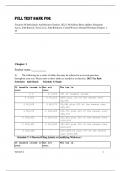Tentamen (uitwerkingen)
Test Bank for Taxation Of Individuals And Business Entities 2022 13th Edition Brian Spilker, Benjamin Ayers, John Barrick, Troy Lewis, John Robinson, Connie Weaver, Ronald Worsham
- Vak
- Instelling
- Boek
Test Bank for Taxation Of Individuals And Business Entities 2022 13th Edition Brian Spilker, Benjamin Ayers, John Barrick, Troy Lewis, John Robinson, Connie Weaver, Ronald Worsham
[Meer zien]




